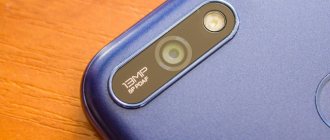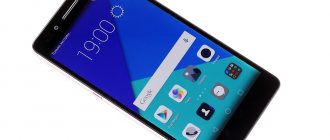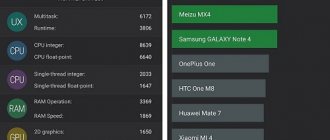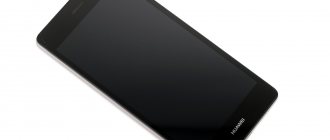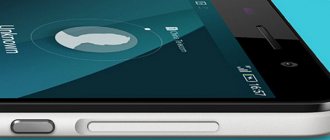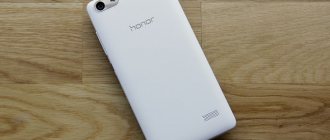Huawei made P Smart 2021, clearly listening to people's aspirations, as if based on a sociological survey. We tick the following boxes: a large screen with minimal bezels, four rear cameras, one of which is 48 megapixels, a mini-jack, a capacious battery (5000 mAh), a 128 GB drive with a dedicated memory card slot. And it seems that the absence of Google services is no longer so striking... Or is it still striking - and this set is not enough?
Huawei P Smart 2021 is quite likely one of the last smartphones that was developed in parallel with its almost identical twin, Honor. We recently talked about the Honor 10X Lite model, which differs from the P Smart 2021 only in a changed shell (Magic UI instead of EMUI), a different design and slightly different wireless modules.
⇡#Technical characteristics
| Huawei P Smart 2021 | Honor 10X Lite | Huawei P40 lite | Xiaomi Redmi Note 9S | vivo Y30 | |
| Display | 6.67 inches, IPS, 2400 × 1080 pixels, 395 ppi, capacitive multi-touch | 6.67 inches, IPS, 2400 × 1080 pixels, 395 ppi, capacitive multi-touch | 6.4 inches, IPS, 2310 × 1080 pixels (19:9), 398 ppi, capacitive multi-touch | 6.67 inches, IPS, 2400 × 1080 pixels, 395 ppi; capacitive, multi-touch | 6.47 inches, IPS, 1560 × 720 pixels, 266 ppi; capacitive, multi-touch |
| Protective glass | No information | No information | No information | Corning Gorilla Glass 5 | Panda Glass |
| CPU | HiSilicon Kirin 710A: eight cores (4 × ARM Cortex A73, 2.0 GHz + 4 × ARM Cortex A53, 1.7 GHz) | HiSilicon Kirin 710A: eight cores (4 × ARM Cortex A73, 2.0 GHz + 4 × ARM Cortex A53, 1.7 GHz) | HiSilicon Kirin 810: eight cores (2 × Cortex-A76, 2.27 GHz + 6 × Cortex-A55, 1.88 GHz) | Qualcomm Snapdragon 720G: eight cores (2 × Kryo 465 Gold, 2.3 GHz and 6 × Kryo 465 Silver, 1.8 GHz) | Mediatek MT6765 Helio P35: eight cores (4 × Cortex-A53, 2.35 GHz + 4 × Cortex-A53, 1.8 GHz) |
| Graphics controller | ARM Mali-G51 MP4 | ARM Mali-G51 MP4 | Mali-G52 MP6 | Adreno 618 | PowerVR GE8320 |
| RAM | 4 GB | 4 GB | 6/8 GB | 4/6 GB | 4 GB |
| Flash memory | 128 GB | 128 GB | 128 GB | 64/128 GB | 128 GB |
| Connector | USB Type-C, 3.5 mm mini-jack | USB Type-C, 3.5 mm mini-jack | USB Type-C | USB Type-C, 3.5 mm mini-jack | USB Type-C, 3.5 mm mini-jack |
| Memory card support | Yes (separate slot for microSD) | Yes (separate slot for microSD) | Yes (hybrid slot for nV/second nano-SIM) | Yes (separate slot for microSD) | Yes (separate slot for microSD) |
| SIM cards | 2 × nano-SIM | 2 × nano-SIM | 2 × nano-SIM | 2 × nano-SIM | 2 × nano-SIM |
| Cellular connection 2G | GSM/GPRS/EDGE 900/1800/1900 MHz | GSM/GPRS/EDGE 900/1800/1900 MHz | GSM 850/900/1800/1900 MHz | GSM/GPRS/EDGE 850/900/1800/1900 MHz | GSM/GPRS/EDGE 850/900/1800/1900 MHz |
| Cellular 3G | HSDPA 850/900/1700/1900/2100 MHz | HSDPA 850/900/1900/2100 MHz | HSDPA 800/850/900/1700/1900/2100 MHz | HSDPA 850/900/1700/1900/2100 MHz | HSDPA 850/900/2100 MHz |
| Cellular 4G | LTE: 1, 3, 5, 7, 8, 20, 28, 38, 40, 41 | LTE: 1, 2, 3, 4, 5, 7, 8, 20, 28, 38, 40, 41 | LTE Cat. 13 (up to 400/75 Mbit/s), bands 1, 2, 3, 4, 5, 7, 8, 18, 19, 20, 28, 34, 38, 39, 40, 41 | LTE, bands 1, 3, 4, 5, 7, 8, 20, 28, 38, 40 | LTE, bands 1, 3, 4, 5, 7, 8, 19, 20, 26, 28, 38, 40, 41 |
| WiFi | 802.11b/g/n; 2.4 GHz | 802.11a/b/g/n/ac; 2.4/5 GHz | 802.11 a/b/g/n; 2.4/5 GHz | 802.11a/b/g/n/ac; 2.4/5 GHz | 802.11a/b/g/n; 2.4/5 GHz |
| Bluetooth | 5.1 | 5.1 | 5.0 | 5.0 | 5.0 |
| NFC | Eat | Eat | Eat | No | Eat |
| Navigation | GPS, A-GPS, GLONASS, BeiDou | GPS, A-GPS, GLONASS, BeiDou | GPS (dual band), A-GPS, GLONASS, BeiDou, Galileo, QZSS | GPS, A-GPS, GLONASS, BeiDou, Galileo | GPS, A-GPS, GLONASS, BeiDou, Galileo |
| Sensors | Illuminance, proximity, accelerometer/gyroscope | Illuminance, proximity, accelerometer/gyroscope | Light, proximity, accelerometer/gyroscope, barometer, magnetometer (digital compass), color spectrum sensor | Illumination, proximity, accelerometer/gyroscope, magnetometer (digital compass) | Illumination, proximity, accelerometer/gyroscope, magnetometer (digital compass) |
| Fingerprint's scanner | Yes, on the side button | Yes, on the side button | Yes (on the side key) | Yes (on the side key) | Yes (rear) |
| Main camera | Quadruple module: 48 + 8 + 2 + 2 MP, ƒ/1.8 + ƒ/2.4 + ƒ/2.4 + ƒ/2.4, phase detection autofocus, LED flash | Quadruple module: 48 + 8 + 2 + 2 MP, ƒ/1.8 + ƒ/2.4 + ƒ/2.4 + ƒ/2.4, phase detection autofocus, LED flash | Quadruple module, 48 + 8 + 2 + 2 MP, ƒ/1.8 + ƒ/2.4 + ƒ/2.4 + ƒ/2.4, phase detection autofocus in the main module, LED flash | Quadruple module: 48 + 8 + 5 + 2 MP, ƒ/1.8 + ƒ/2.2 + ƒ/2.4 + ƒ/2.4, phase detection autofocus, single LED flash | Quadruple module: 13 + 8 + 2 + 2 MP, ƒ/2.2 + ƒ/2.2 + ƒ/2.4 + ƒ/2.4, phase detection autofocus, single LED flash |
| Front-camera | 8 MP, ƒ/2.0, no autofocus, no flash | 8 MP, ƒ/2.0, no autofocus, no flash | 16 MP, ƒ/2.0, fixed focus, no flash | 16 MP, ƒ/2.5, without autofocus, with flash | 8 MP, ƒ/2.1, without autofocus, with flash |
| Nutrition | Non-removable battery: 19 Wh (5000 mAh, 3.8 V) | Non-removable battery: 19 Wh (5000 mAh, 3.8 V) | Non-removable battery: 15.96 Wh (4200 mAh, 3.8 V) | Non-removable battery: 19.08 Wh (5020 mAh, 3.8 V) | Non-removable battery: 19 Wh (5000 mAh, 3.8 V) |
| Size | 165.7 × 76.9 × 9.3 mm | 165.7 × 76.9 × 9.3 mm | 159 × 76 × 8.7 mm | 165.8 × 76.7 × 8.8 mm | 162 × 76.5 × 9.1 mm |
| Weight | 206 g | 206 g | 183 g | 209 g | 197 g |
| Housing protection | No | No | No | Splash protection | No |
| operating system | Android 10, EMUI 10 shell (without Google services) | Android 10, Magic UI shell (without Google services) | Android 10, EMUI 10 shell (without Google services) | Android 10, MIUI 11 shell | Android 10, FunTouch OS 10 shell |
| Current price | 15,588 rubles | 15,790 rubles | 16,990 rubles for the 6/128 GB version | 15,290 rubles for the 4/64 GB version, 16,890 rubles for the 6/128 GB version | 13,990 rubles |
| Information on technical characteristics and subsystems of Huawei P Smart 2021 | ||||
Work and autonomy
A decent, although not record-breaking, 3400 mAh battery capacity paired with energy-efficient hardware and optimized software gives the smartphone decent autonomy, even taking into account the 6.21-inch IPS screen. The smartphone, even with active use, survives until the end of the day with a good battery reserve. The time the screen is on on one charge, depending on its brightness, is up to 7-8 hours.
Fully charging the battery from the original power supply takes approximately 1 hour 40 minutes.
During 3 weeks of use, none of the smartphone’s functions raised any complaints.
⇡#Design, ergonomics and software
There is no point in discussing the design of Huawei P Smart 2021. You will be able to describe it yourself, even if you have not seen this device, simply based on your acquaintance with other smartphones released in 2020. A large screen with minimal frames, the front camera is in a hole (the only intrigue is in the corner or in the center; here in the center), the back is mirrored, with beveled edges, and in its corner there is a massive block with four lenses. This is such a modern classic.
The back, however, is made not of glass, but of plastic, but in appearance it looks like glass, although the difference is, of course, already noticeable to the touch. The edges are also plastic - to understand this, you need to pay attention to the absence of veins for antennas; they are not required here.
Huawei P Smart 2021, front panel: front camera in the hole in the center of the top of the display, even higher is the earpiece
Another must-have element in 2020, but specifically for an inexpensive smartphone, is a fingerprint scanner on the side panel. Rear scanners have become blatantly unfashionable - the current style requires as much as possible to avoid inclusions on both the front and rear panels. So the power key here is large, flat and slightly recessed into the body.
Huawei P Smart 2021, rear panel: in the corner there is a block with four cameras and a single LED flash
There are two color versions: bright green (as in our case) and midnight black.
Huawei P Smart 2021, left side: slot for SIM cards and memory cards
Huawei P Smart 2021, right side: power/lock key combined with a fingerprint scanner and volume key
The dimensions of the Huawei P Smart 2021 inspire, if not awe, then at least respect - prepare your pockets wider and train your fingers. A smartphone with a 6.67-inch screen should be chosen with full awareness of how such a huge thing fits in your hands. I note that the back here is quite slippery, but it doesn’t go to extremes - I wouldn’t say that the gadget just tears out of the palm of your hand and slides away from any surface. Nevertheless, the kit includes a silicone case, and it is better to carry the P Smart 2021 in it, even though it will inflate the already rather large dimensions of the device.
Huawei P Smart 2021, top edge: microphone
Huawei P Smart 2021, bottom edge: mini-jack, microphone, USB Type-C port, speaker
The functional elements are standard, without any unpleasant surprises: a USB Type-C port, a mini-jack, a pair of microphones, a slot for SIM cards and memory cards with a pin lock, and I have already mentioned the features of the power key above.
The side-mounted fingerprint scanner suffers somewhat from an insufficient coverage area, which is why sometimes you have to touch it several times before it finally fulfills its duties, but it suffers from hypersensitivity, which leads to unnecessary unlocking of the device right in your pocket (like the Sony Xperia 1 II/5 II), bypassed him. In addition, the scanner can be duplicated by a facial recognition system, which, however, relies only on a single front camera, without additional sensors.
Screenshot gallery
View all images (17)EMUI 11 has not yet reached entry-level or mid-level smartphones - it remains exclusive to Huawei Mate 40 Pro. Here is the very familiar EMUI 10.1.1 without Google services and without the prospect of their appearance. We have already written a lot about all the features of coexistence with a smartphone without Google, but I won’t repeat it. AppGallery is in place, as is the Petal Search service, which allows you to search the Internet for apk files of applications that are not available in the company store. Not all will be installed, but most will be installed - American sanctions do not pose any serious obstacles to the use of a smartphone. Otherwise, the EMUI shell, as always, is beautiful, works quickly and pleases with a reasonable interface.
Appearance, packaging and assembly
In addition to the smartphone, documentation and 2A charger, the compact cardboard box also contains an audio headset.
Huawei P Smart 2019 is available in two shades: black and glossy emerald blue, with a gradient color transition from the top to the bottom of the smartphone. In the photo, this shade looks very bright, even parrot-like, but in reality, due to the glossy surface, the bright shade adapts to external lighting and acquires mirror-like properties. In general, this solution looks interesting and original, but still “not for everyone” and will probably appeal to girls more. At the same time, if such an effect is pampering for you, then you can choose a classic black color.
This model has a non-removable battery and rounded edges, as a result of which the body feels monolithic and streamlined in the hands.
The front side of Huawei P Smart 2021 is made of glass with an oleophobic coating, however, the protective qualities of glass in Huawei smartphones in this price range are traditionally not noticeable, so it is better to immediately buy protective glass or film. The frames around the screen are minimal - about 1-2mm on the top and sides, about 4mm on the bottom.
At the top there is a fashionable drop-shaped cutout for the front camera, which allows you to make maximum use of the usable area of the front panel, and just above there is an almost invisible speaker.
At the top of the device there is a slot for SIM and SD cards.
On the bottom edge there is an audio output, a microphone, the good old microUSB (instead of the expected USB Type C in 2021) and a speaker. In my opinion, it is more convenient when the audio output is located at the top of the device; when connecting headphones, the smartphone does not need to be turned upside down.
The back panel of Huawei P Smart 2021 is made of glossy plastic.
There is a dual camera in the upper left corner, a fingerprint scanner in the center, the brand name at the bottom, nothing more.
The easily soiled plastic case raises questions about its resistance to scratches, so I would recommend immediately purchasing a case.
The volume rocker and the power button are located on the right side, it should be noted that the optimal height of the location is, they are convenient to press with both a small, female palm and a male one, and also does not cause inconvenience to use the buttons for a left-handed person.
In conclusion, I would like to note the stylish and laconic design and interesting colors of the case; the smartphone will be able to stand out and attract attention. The glossy gradient of the back cover is clearly not for everyone. The build quality is not satisfactory.
⇡#Display and sound
Huawei P Smart 2021 has a 6.67-inch diagonal IPS LCD display with Full HD+ resolution (2400 × 1080 pixels). The same as in Honor 10X Lite, plus competitors from Xiaomi (Redmi Note 9S/Pro, POCO X3 NFC) also sport screens with similar characteristics. The pixel density is low, but sufficient for the picture to be perceived normally - 395 ppi.
The viewing angles are wide, there is an effective oleophobic coating, and there is a “factory” film glued to the screen. It will quickly become covered with scratches, but at first you don’t have to remove it.
The measured maximum brightness level without software enhancement during auto-adjustment is 455 cd/m2 - the average result of an LCD screen. The contrast is normal - 1186:1.
The screen settings are familiar: there is a dark theme, you can set the font size and resolution. Color reproduction can be adjusted by choosing from two presets (“bright” and “normal”), plus it is possible to adjust the color temperature to your taste. I measured color rendering with the Vivid and Normal presets at the default color temperature.
Huawei P Smart 2021, bright mode, gamma. Yellow line – P Smart 2021 indicators, dotted line – reference range
Huawei P Smart 2021, bright mode, color temperature. Blue line – P Smart 2021 indicators, dotted line – reference temperature
Huawei P Smart 2021, bright mode, color gamut. Gray triangle – sRGB coverage, white triangle – P Smart 2021 coverage
The P Smart 2021 screen does not go far beyond the sRGB standard - even in bright mode, the color gamut is only slightly superior to the traditional triangle. At the same time, he achieves the sensation of saturated colors primarily with the help of increased color temperature, at the level of 8,500-8,800 K - cool shades are perceived as brighter, white looks downright snowy. The gamma is adequate - 2.19. The average DeltaE deviation for the extended Color Checker palette (shades of gray + a wide range of color shades) is 5.80, with a norm of 3.00.
Huawei P Smart 2021, normal mode, gamma. Yellow line – P Smart 2021 indicators, dotted line – reference range
Huawei P Smart 2021, normal mode, color temperature. Blue line – P Smart 2021 indicators, dotted line – reference temperature
Huawei P Smart 2021, normal mode, color gamut. Gray triangle – sRGB coverage, white triangle – P Smart 2021 coverage
In normal mode, the color gamut already exactly corresponds to the sRGB standard, the color temperature warms up, approaching the reference value of 6,500 K, and the gamma remains virtually unchanged (2.21). The average deviation DeltaE on the Color Checker scale is already within the normal range - 2.40. Fans of natural shades will love the Huawei P Smart 2021 screen.
Huawei P Smart 2021 carries on board both a mini-jack and Bluetooth version 5.1 - however, it has nothing special to please the audiophile, the sound path itself is standard, the sound produces mediocre, and Bluetooth lacks support for key high-resolution data transfer profiles, such like aptX and aptX HD, although it should be compatible with LDAC. The external speaker is monophonic, also quite ordinary.
Screen
One of the main differences between the 2021 Huawei P Smart and the 2018 model is the screen. Its diagonal has grown from 5.26 to 6.21 inches, while the top frame has practically disappeared and received a drop-shaped Dewdrop cutout, like the older models, and the bottom has become significantly smaller. In this case, the cutout can be disguised by turning on the display of the dark panel - the color will match almost perfectly. All 4 corners of the screen are curved.
A resolution of 1080x2340 pixels at such dimensions provided a high pixel density of ~416 PPI. The aspect ratio was 19.5:9.
The expensive AMOLED matrix did not fit into the price tag of the smartphone, so a traditional IPS screen is used here, but using modern LTPS technology. The color rendition, viewing angles and brightness adjustment range of the screen are excellent.
Among the display settings, it is worth highlighting switching between two modes – “normal” and “saturated”, as well as turning on the eye protection mode. The latter makes colors warmer, significantly reducing the presence of blue tones. Enabling the saturated mode, excuse the taftology, makes the colors really saturated, trying to “reach” them for AMOLED displays. At the same time, the tones are significantly shifted towards cold ones, which can be partially compensated by changing the color temperature to a warmer one on the same settings screen.
In general, the screen can be considered one of the advantages of a smartphone - this picture quality can be seen on more expensive devices.
⇡#Hardware and performance
Huawei P Smart 2021 has a simplified version of the HiSilicon Kirin 710 platform - Kirin 710A, which is made using a 14-nanometer process technology instead of a 12-nanometer one. This is such an inexplicable downgrade even relative to last year’s Huawei/Honor, not to mention its closest neighbor in the lineup Huawei P40 Lite with its Kirin 810 (which never became widespread).
The composition of HiSilicon Kirin 710A has not changed: four ARM Cortex-A73 clocked at 2.0 GHz and four ARM Cortex-A53 clocked at 1.7 GHz. The graphics subsystem is the same - ARM Mali-G51 MP4. There is also a dedicated processor for operations related to machine learning.
It is very interesting that according to the results of synthetic tests, Huawei P Smart 2021 slightly outperforms its twin Honor 10X Lite, which has the same hardware platform and the same amount of RAM. This can only be explained by the difference in software optimization. But there is no radical advantage; the gaming potential of the P Smart 2021 remains very limited, but in productivity mode you can squeeze something out of this smartphone. As you can see, of all the smartphones in our selection, Huawei P Smart 2021 is noticeably behind only Redmi Note 9S/Pro.
But there are problems with throttling - in the CPU Throttling Test benchmark, a drop in peak frequency of up to 54% was recorded. It occurs towards the end of the 15-minute session, but it does not represent a short dip, but a stable decline, and this is a bad signal. There will be problems in long gaming sessions.
Huawei P Smart 2021 is equipped with 4 GB of LPDDR4X RAM and 128 GB of UFS 2.1 flash. And despite the fact that we are talking about a Huawei smartphone, there is a separate slot available for a common microSD card - firstly, not for branded NM, but for regular microSD, and secondly, it is not combined with a SIM card tray.
Review of Huawei P smart
The Huawei P smart smartphone was officially announced on the Russian market in January 2021. P Smart is the European version of the Enjoy 7S smartphone. The features of P Smart include the fact that photo and video shooting here can be controlled with a wave of your hand. In addition, the smartphone has a special function that divides the display into two parts.
Appearance and ergonomics
The P Smart body is made of aluminum alloy. Refined severity is diluted by two plastic inserts at the top and bottom. The design is not new, but the gadget looks stylish and feels nice in the hand. The dimensions of the device are 72x150x7.45 mm, weight is only 143 g, compact and very thin.
All elements on the front side are arranged as standard - the top part: earpiece, front camera, light sensor. The screen, made using the full lamination method, occupies about 80% of the front panel. On the back of the smartphone there is a logo and a fingerprint sensor. The flash and two windows of the main camera are located on a plastic insert. Huawei P Smart is available in the following colors: black, blue, gold and rose gold.
Display
Despite its very modest dimensions, Huawei P smart has a fairly large screen with a diagonal of 5.65 inches and a resolution of 1080x2160 pixels. The screen brightness of the gadget is enough to see the picture without strain even in direct sunlight. At the same time, in the dark it is quite comfortable when reading and viewing, automatic brightness adjustment and the light sensor work perfectly. Maximum viewing angles, pleasant tactile sensations, high response speed to touch.
Another feature of P Smart is the oleophobic coating, which “softens” the screen to the touch. The FHD+ resolution is not enough to comfortably display small details on such large screens; this only applies to those cases when we are talking about Internet sites that are not adapted for mobile devices. The resolution in Huawei P smart can not only be changed manually, but also automatically adjusted depending on power consumption.
Hardware and performance
The performance of P Smart is ensured by the HiSilicon Kirin 659 processor with two clusters of 4 ARM Cortex-A53 cores with a clock frequency of 2.36 GHz, in-house production, graphics accelerator - Mali-T830 MP2 and 3 GB or 4 GB of RAM. Thanks to this processor, the proprietary Emotion 8.0 system based on Android Oreo works stably. However, for games like World of Tanks Blitz, the performance is no longer enough. At maximum graphics settings, the game starts, but the frame rate starts to jump - 10-17 FPS. Switching to medium settings, the frequency rises to 30-35 frames per second. In the updated Antutu test, the smartphone scores almost 88 thousand points. The gadget runs on Google Android OS version 8.0, which is quite good considering the price segment. Most similar smartphones are still on the “seven”.
A very important addition to the Kirin 659 is the i5 coprocessor, which is responsible for the functioning of peripheral sensors, as well as components in the background. Let’s say that if the owner does not close the navigation application, and it, in turn, continues to use GPS and hang in the memory, then the entire load falls on the energy-efficient i5, which significantly reduces the power consumption of the P smart at rest. The internal memory capacity is 32 GB or 64 GB depending on the version. In addition, memory cards up to 256 GB are supported, but only instead of one SIM card, a separate slot is not provided. The 3000 mAh battery lasts for a maximum of one day, with a continuous 3-hour screen light and two SIM cards installed. With medium settings and gentle mode, the device can last a full day. The saving grace is that the smartphone has a Micro USB port, which means that finding a compatible cable at work will not be difficult.
Communication and sound
Huawei P smart is equipped with a mono speaker for hands-free calling. The sound is clear and loud; you won’t be able to muffle it by covering it with your hand. There is a miniJack connector (3.5 mm). The sound is excellent, like for a smartphone. Huawei Histen sound significantly changes the sound of the gadget in headphones: there are several equalizer settings, optimization for the type of headphones, and “volume” effects. The smartphone is equipped with its own audio player with various options and support for song tests. There is Bluetooth version 4.2 LE, A2DP, with connection to up to 2 devices simultaneously. Huawei P Smart supports 2.4 GHz, LTE and 3G Wi-Fi networks. The navigation module works with Glonass, GPS, AGPS and compass.
Camera
From 2021, all smartphones will be released with two camera modules. Huawei P Smart is equipped with two main cameras: one is used to create a digital bokeh effect, and the other takes regular pictures in 13 MP (f/2.0). The quality of photographs is traditionally at a high level. Video recording at Full HD level, flow rate - 17 Mbit/s. If you do not plan to create cinematic masterpieces with it, then the camera will be enough for you.
conclusions
The cost of Huawei P Smart is set at around 15 thousand rubles. This is a very symbolic price for a device with such a stylish design, a screen with Full HD+ resolution and two cameras. An excellent gadget for high school students, students, and fans of casual design. The standard package includes a smartphone, power supply, Micro USB cable, screen protector and warranty card.
Pros:
- Metal body.
- Stylish design.
- Dual main camera.
- Screen with Full HD+ resolution.
- Decent performance.
Minuses:
- Weak autonomy.
- The performance of the gadget does not allow you to comfortably play heavy games.
⇡#Communications and wireless communications
The smartphone has two slots for nano-SIM; both cards can work with LTE. The speed at which the LTE modem can transmit data is not specified, but it is known that at least all the bands necessary for the correct operation of networks are supported.
Slot for two nano-SIM cards and a microSD memory card
One of the puzzling points about the Huawei P Smart 2021 is the Wi-Fi module, which only works with the 2.4 GHz band (802.11b/g/n). When even ultra-budgeters have learned to work with 802.11a/b/g/n/ac in the 2.4 and 5 GHz bands, such a limitation looks strange. Otherwise, everything is as usual - Bluetooth 5.1, navigation module with support for GPS (A-GPS), GLONASS and BeiDou. The Russian version has NFC - the lack of support for Google Pay may be confusing, but it can be replaced using the Wallet and Sber Pay services available in the AppGallery.
⇡#Camera
Huawei P Smart 2021 received four cameras at once: two of them are directly responsible for photography with two different viewing angles, another is for macro photography, and the fourth is a so-called depth sensor to help create artificial bokeh (most often you can do without it ).
The main camera has a 48-megapixel Quad Bayer sensor (physical dimensions - 1/2.0 inch) with an ƒ/1.8 aperture lens, phase detection autofocus and an equivalent focal length of 28 mm. The second camera is responsible for an expanded viewing angle - it is an 8-megapixel module (physical dimensions - 1/4.0 inch) with an ƒ/2.4 aperture lens, giving a coverage angle of 120 degrees. It lacks autofocus.
| On the left are pictures taken with the main camera, on the right – with the wide-angle camera | ||
The quality of shooting with the main camera is as expected - or at least expectedly good: after all, we have already seen a whole lot of smartphones with 48-megapixel modules. Huawei’s skill in setting up software processing and using neural network calculations to “finish up” the result also helps here - during the day this is not so noticeable, and I would not say that the dynamic range is radically expanded thanks to “artificial intelligence”, and the detailing maintains a balance between naturalness and trying to take the sharpest photo possible. In low light, the neural networks (can be turned off, just click on the AI icon at the top of the camera application) are already in full swing: colors become brighter, saturation increases, and contour sharpness catches the eye. But for a smartphone in this price range, I would say prioritizing flashiness over naturalness is the right choice. At a minimum, you can get a normal picture that you are not ashamed to publish on social networks in almost any light. Especially by turning on the night mode, which we’ll talk about in more detail below. The wide-angle camera performs well in good lighting, but fails in the dark - especially since the night mode is no longer available for it. I will note the stable white balance, which does not change when choosing a viewing angle.
| From left to right: standard field of view, wide field of view, 2x software zoom | ||||
Zoom is only available digitally – up to six times. Good quality is maintained if you take a picture in normal lighting conditions with a 2x zoom. It is also worth saying that by default, shooting with the main module is offered with a resolution of 12 megapixels, but if you wish, you can select a 48-megapixel mode.
| On the left is a photo in standard mode, on the right is in night mode | ||
The main camera does not have an optical stabilizer, which does not interfere with taking sharp pictures even in low light - not only at dusk, but also at night. Using night mode with multi-frame exposure stitching and subsequent “finishing” of the picture using machine learning technologies is not at all necessary. With it, the picture looks less natural, “overstuffed”, but brighter and clearer - the system works in the traditional way for Huawei. Be that as it may, in its class, Huawei P Smart 2021 is probably the best smartphone in terms of night photography.
The third camera is responsible for macro photography. Due to the two-megapixel sensor, the pictures are of low resolution, but with sufficient lighting you can squeeze interesting close-ups out of this camera.
The fourth camera is a depth sensor used in portrait mode, in which a single focal length is available, pushing for shooting full-length or half-length portraits: this way spatial distortions are not noticeable. The blur is of high quality, there are proprietary filters in the form of “discs”, “hearts” and the like. The system draws no worse than in the Huawei P40 Pro.
The camera application is typical for smartphones with EMUI: horizontal navigation, a set of familiar settings. A “professional” mode with manual settings is available, but without the ability to shoot in RAW.
Gallery of pictures
View all images (22)In video shooting, the capabilities of Huawei P Smart 2021 are limited to Full HD resolution with a frequency of up to 60 frames per second. There is conditional (not very effective) digital stabilization.
The front camera has an 8-megapixel sensor and ƒ/2.0 aperture optics. There is no autofocus or flash. The shooting quality is average (the dynamic range is weak, the camera is lukewarm in terms of color rendering, the angle is too wide), but there is a portrait mode and a beauty feature.
Smart Cameras
There are often situations when you need to quickly and accurately capture a moment, but there is no way to tinker with the camera settings. With Huawei P smart+ this is not a problem: in addition to custom hardware solutions, its cameras are equipped with AI algorithms that help create great pictures. The dual main camera of Huawei P smart+ consists of sensors with a resolution of 16 MP and 2 MP. The first captures bright images and is responsible for video shooting, and the additional one records image depth data, which allows you to separate the object from the surrounding background in the final image, creating the effect of a shallow depth of field. It works quite impressively. Occasionally, in difficult conditions, the algorithms make mistakes, but in most cases the result is satisfactory. Photos become similar to those taken with system cameras with high-aperture optics.
The new AI-enabled hardware platform makes Huawei P smart+ capable of distinguishing more than 500 shooting scenes in 22 categories, thereby optimizing images when taking pictures. Among other things, the camera recognizes a panda without any problems. Apparently, this is a tribute to cultural traditions from a Chinese manufacturer (not everyone knows, but this touching creature is native to the Celestial Empire, where the black and white bear is proudly considered a national treasure).
AI has long proven its effectiveness in image recognition tasks and it is quite obvious that it is being used in smartphone cameras. The application analyzes the objects in the frame and selects the appropriate settings for a specific scene so that what ends up in the viewfinder looks as attractive as possible.
This, as it may seem at first glance, is not only saturation, but also an analysis of the light and shadow pattern, the location of objects in the composition, and so on. Thus, the capabilities of the smartphone will be enough to get an excellent shot in the “take it out and shoot” mode.
There are no perfectly working algorithms, and developments from Huawei are no exception. In some scenes, the AI mode can be a little overzealous, increasing saturation to unacceptable levels or, for example, over-brightening shadows, resulting in noise.
The developers are probably aware of some shortcomings in the system’s operation, and with future updates there will probably be fewer such issues.
The operation of the main module with activated AI mode can be assessed from the pictures in the gallery:
If you have any creative idea, it is better to implement it using manual settings. Fortunately, there is such an opportunity here, as well as saving the image in RAW format for later processing.
Having analyzed the work of intelligent algorithms, we can draw an unambiguous conclusion - it works and the pictures really turn out much better in the vast majority of cases.
One of the distinctive features of Huawei P smart+ is the symbiosis of the front camera with a 24-megapixel main sensor and an additional one with a resolution of 2 MP. Working together with software algorithms, the cameras create excellent images that are not inferior in quality to the main camera. The front camera's intelligence recognizes more than 200 shooting conditions in eight categories and automatically applies the most appropriate settings when taking photos.
Another important feature is that the front camera supports HDR shooting. The HDR Pro option, together with the algorithm, allows you to take excellent pictures with perfect color reproduction, maintaining an optimal balance of light and shadow. With this function, you can avoid overexposure on the subject and background. The effectiveness will be clearly visible when shooting in backlight.
In addition to smart photography, Huawei P smart+ has a smart image gallery that automatically sorts our photos into categories and finds them on demand.
You can see photos and videos taken by Huawei P smart+ at this link for detailed information.
⇡#Autonomous work
Huawei P Smart 2021 has a capacious battery - 19 Wh (5000 mAh, 3.8 V). Despite the simple hardware platform (don’t forget about the 14nm process technology, which affects energy efficiency), it does not provide much of an advantage in terms of autonomy over its competitors. It simply compensates for the “damage” that a large screen causes. Be that as it may, the P Smart 2021 lives quite quietly all day long with a standard usage scenario (a little social networks, a little messenger, a little calls, a little game - and in total a lot of time with the screen on) - it’s hard to ask for more from a modern smartphone .
In our traditional test with Full HD video playback at maximum brightness, with Wi-Fi turned on and notifications running, Huawei P Smart 2021 showed an average result of just over 10 hours.
The current USB Type-C port is used for charging, and a fast charging adapter (22.5 W) is included. With its help, you can charge Huawei P Smart 2021 in about an hour and forty-five minutes.
Sound
the sound of Huawei P Smart 2019 in all aspects. The smartphone is equipped with one external speaker located on the bottom right side, so it does not overlap in any position. The sound has a sufficient maximum volume, while in addition to the high frequencies, the mid frequencies are also quite readable, and even at maximum volume there are no obvious wheezes. The speaker also did not disappoint - the sound is quite readable.
The sound in the monitor headphones was frankly pleasing - with an impedance of 64 Ohms, the volume was even with a reserve, and even at maximum volume all frequencies remained clearly readable, and the bass was impressive in depth.
Lossless tracks in the standard player with the patented enhancement function from HISTEN enabled sound especially good.

